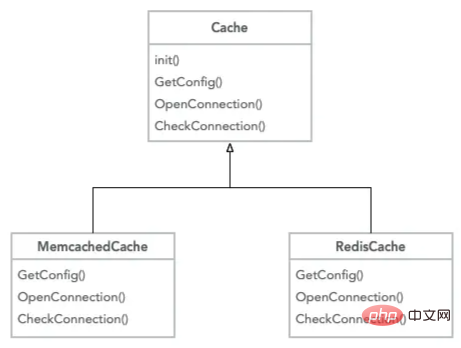An in-depth analysis of the template method pattern in PHP
In the previous article "Understand the facade pattern in PHP in one article" we introduced the facade pattern in PHP. This article will take you to understand the template method pattern in PHP design pattern.

The template method pattern is also one of the patterns that we often use inadvertently. This model is the best interpretation of inheritance. When there are repeated actions in the subclass, they are extracted and placed in the parent class for unified processing. This is the simplest and most popular explanation of the template method pattern. Just like when we usually do projects, the process of each project is actually the same, including research, development, testing, deployment and online processes. In each project, the implementation of these processes will not be exactly the same. This process is like a template method, allowing us to develop according to this process every time.
Gof class diagram and explanation
GoF definition: Define the skeleton of an algorithm in an operation, while deferring some steps to subclasses . TemplateMethod allows subclasses to redefine specific steps of an algorithm without changing the structure of the algorithm.
GoF class diagram

##Code implementation
abstract class AbstractClass
{
public function TemplateMethod()
{
$this->PrimitiveOperation1();
$this->PrimitiveOperation2();
}
abstract public function PrimitiveOperation1();
abstract public function PrimitiveOperation2();
}class ConcreteClassA extends AbstractClass
{
public function PrimitiveOperation1()
{
echo '具体类A实现方法1', PHP_EOL;
}
public function PrimitiveOperation2()
{
echo '具体类A实现方法2', PHP_EOL;
}
}
class ConcreteClassB extends AbstractClass
{
public function PrimitiveOperation1()
{
echo '具体类B实现方法1', PHP_EOL;
}
public function PrimitiveOperation2()
{
echo '具体类B实现方法2', PHP_EOL;
}
}$c = new ConcreteClassA(); $c->TemplateMethod(); $c = new ConcreteClassB(); $c->TemplateMethod();
- I believe that anyone who has done some object-oriented development will have used the template method pattern to some extent. Because it is very commonIn some frameworks, some functional classes often have the function of initialization, and many other internal functions are called in the initialization function. This is actually an application of the template method patternThe template method pattern can easily implement hook functions. Just like many templates or hook functions prepared for you in open source systems. For example, some blog open source programs will reserve some advertising spaces or hook functions in special locations for users to implement on demand. The template method pattern is suitable for: implementing the unchanged part of an algorithm at one time, and The variable parts are left to the subclass to implement; the common behaviors in the subclass are extracted and concentrated into the parent class; the extension of the subclass is controlled; This model embodies a thing called the "Hollywood Law" The principle is "Don't come to us, we come to you"
In the company, I highly recommend agile project management. Of course, this does not mean traditional project management. No matter how bad it is, it's just that agile is more suitable for a short-term, flat and fast company like ours. In agile, we use the Scurm framework, which is actually a template. It defines four types of meetings, three types of people, and three tools. In the specific implementation of each project, we will abide by these rules, but the specific implementation will not be the same. For example, sometimes we iterate once a week, and sometimes we iterate once a month. Sometimes we don't need a retrospective meeting, but hold the retrospective and review meetings together. No matter what, we will carry out flexible project development based on Scurm. As a leader, I only need to call up the basic process of Scurm in each project. Therefore, the strength of the company is inseparable from everyone’s learning. Of course, useful things must be learned, shared and applied all the time! !
Full code: https://github.com/zhangyue0503/designpatterns-php/blob/master/20.template-method/source/template-method.php
Example
No more text messages. This time we implement the initialization part of a Cache class. Just like the tool classes in some frameworks mentioned above. Generally, we will use Memcached or Redis to implement Cache, so we extract a public Cache class, and then let the Cache implementation classes of Memcached and Redis inherit it. In the public class, some initialization work of the implementation class is performed through template methods. These tasks are uniformly called by the parent class. The implementation class only needs to implement the specific content of each step.Cache class diagram

Full source code: https://github.com/zhangyue0503/designpatterns-php/ blob/master/20.template-method/source/template-method-cache.php<?php abstract class Cache { private $config; private $conn; public function __construct() { $this->init(); } public function init() { $this->GetConfig(); $this->OpenConnection(); $this->CheckConnection(); } abstract public function GetConfig(); abstract public function OpenConnection(); abstract public function CheckConnection(); } class MemcachedCache extends Cache { public function GetConfig() { echo '获取Memcached配置文件!', PHP_EOL; $this->config = 'memcached'; } public function OpenConnection() { echo '链接memcached!', PHP_EOL; $this->conn = 1; } public function CheckConnection() { if ($this->conn) { echo 'Memcached连接成功!', PHP_EOL; } else { echo 'Memcached连接失败,请检查配置项!', PHP_EOL; } } } class RedisCache extends Cache { public function GetConfig() { echo '获取Redis配置文件!', PHP_EOL; $this->config = 'redis'; } public function OpenConnection() { echo '链接redis!', PHP_EOL; $this->conn = 0; } public function CheckConnection() { if ($this->conn) { echo 'Redis连接成功!', PHP_EOL; } else { echo 'Redis连接失败,请检查配置项!', PHP_EOL; } } } $m = new MemcachedCache(); $r = new RedisCache();Copy after loginDescription
- We have implemented such a simple cache class. Is it very similar to the code in many frameworks?
- Subclasses only need to define their own implementation, and the rest of the repeated code is left to the parent class. If there is no parent class, they all need to implement an init() method themselves
- Of course, when you need to add other implementation classes, you only need to inherit this Cache parent class and complete your own implementation. Clients can face these implementation classes very easily because they know that they only need to call initialization first. Methods can use this class, no matter which implementation class it is, it is the same
Original address: https://juejin.cn/post/6844903989348139021
Author :Hard-core project manager
Recommended learning: "PHP Video Tutorial"
The above is the detailed content of An in-depth analysis of the template method pattern in PHP. For more information, please follow other related articles on the PHP Chinese website!

Hot AI Tools

Undresser.AI Undress
AI-powered app for creating realistic nude photos

AI Clothes Remover
Online AI tool for removing clothes from photos.

Undress AI Tool
Undress images for free

Clothoff.io
AI clothes remover

AI Hentai Generator
Generate AI Hentai for free.

Hot Article

Hot Tools

Notepad++7.3.1
Easy-to-use and free code editor

SublimeText3 Chinese version
Chinese version, very easy to use

Zend Studio 13.0.1
Powerful PHP integrated development environment

Dreamweaver CS6
Visual web development tools

SublimeText3 Mac version
God-level code editing software (SublimeText3)

Hot Topics
 1379
1379
 52
52
 PHP 8.4 Installation and Upgrade guide for Ubuntu and Debian
Dec 24, 2024 pm 04:42 PM
PHP 8.4 Installation and Upgrade guide for Ubuntu and Debian
Dec 24, 2024 pm 04:42 PM
PHP 8.4 brings several new features, security improvements, and performance improvements with healthy amounts of feature deprecations and removals. This guide explains how to install PHP 8.4 or upgrade to PHP 8.4 on Ubuntu, Debian, or their derivati
 How To Set Up Visual Studio Code (VS Code) for PHP Development
Dec 20, 2024 am 11:31 AM
How To Set Up Visual Studio Code (VS Code) for PHP Development
Dec 20, 2024 am 11:31 AM
Visual Studio Code, also known as VS Code, is a free source code editor — or integrated development environment (IDE) — available for all major operating systems. With a large collection of extensions for many programming languages, VS Code can be c
 7 PHP Functions I Regret I Didn't Know Before
Nov 13, 2024 am 09:42 AM
7 PHP Functions I Regret I Didn't Know Before
Nov 13, 2024 am 09:42 AM
If you are an experienced PHP developer, you might have the feeling that you’ve been there and done that already.You have developed a significant number of applications, debugged millions of lines of code, and tweaked a bunch of scripts to achieve op
 How do you parse and process HTML/XML in PHP?
Feb 07, 2025 am 11:57 AM
How do you parse and process HTML/XML in PHP?
Feb 07, 2025 am 11:57 AM
This tutorial demonstrates how to efficiently process XML documents using PHP. XML (eXtensible Markup Language) is a versatile text-based markup language designed for both human readability and machine parsing. It's commonly used for data storage an
 Explain JSON Web Tokens (JWT) and their use case in PHP APIs.
Apr 05, 2025 am 12:04 AM
Explain JSON Web Tokens (JWT) and their use case in PHP APIs.
Apr 05, 2025 am 12:04 AM
JWT is an open standard based on JSON, used to securely transmit information between parties, mainly for identity authentication and information exchange. 1. JWT consists of three parts: Header, Payload and Signature. 2. The working principle of JWT includes three steps: generating JWT, verifying JWT and parsing Payload. 3. When using JWT for authentication in PHP, JWT can be generated and verified, and user role and permission information can be included in advanced usage. 4. Common errors include signature verification failure, token expiration, and payload oversized. Debugging skills include using debugging tools and logging. 5. Performance optimization and best practices include using appropriate signature algorithms, setting validity periods reasonably,
 PHP Program to Count Vowels in a String
Feb 07, 2025 pm 12:12 PM
PHP Program to Count Vowels in a String
Feb 07, 2025 pm 12:12 PM
A string is a sequence of characters, including letters, numbers, and symbols. This tutorial will learn how to calculate the number of vowels in a given string in PHP using different methods. The vowels in English are a, e, i, o, u, and they can be uppercase or lowercase. What is a vowel? Vowels are alphabetic characters that represent a specific pronunciation. There are five vowels in English, including uppercase and lowercase: a, e, i, o, u Example 1 Input: String = "Tutorialspoint" Output: 6 explain The vowels in the string "Tutorialspoint" are u, o, i, a, o, i. There are 6 yuan in total
 Explain late static binding in PHP (static::).
Apr 03, 2025 am 12:04 AM
Explain late static binding in PHP (static::).
Apr 03, 2025 am 12:04 AM
Static binding (static::) implements late static binding (LSB) in PHP, allowing calling classes to be referenced in static contexts rather than defining classes. 1) The parsing process is performed at runtime, 2) Look up the call class in the inheritance relationship, 3) It may bring performance overhead.
 What are PHP magic methods (__construct, __destruct, __call, __get, __set, etc.) and provide use cases?
Apr 03, 2025 am 12:03 AM
What are PHP magic methods (__construct, __destruct, __call, __get, __set, etc.) and provide use cases?
Apr 03, 2025 am 12:03 AM
What are the magic methods of PHP? PHP's magic methods include: 1.\_\_construct, used to initialize objects; 2.\_\_destruct, used to clean up resources; 3.\_\_call, handle non-existent method calls; 4.\_\_get, implement dynamic attribute access; 5.\_\_set, implement dynamic attribute settings. These methods are automatically called in certain situations, improving code flexibility and efficiency.




